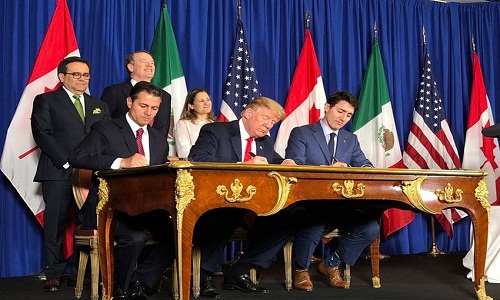"The signing of a new regional trade deal between Mexico, the United States and Canada, on November 30, 2018 in Argentina, augers well for the Mexican garment and apparel industry. The deal, known by the acronyms USMCA in the United States, CUSMA and ACEUM in Canada, and T-MEC in Mexico, replaces the North American Free Trade Agreement (NAFTA), operation since the last 24 years in the three countries’ joint trading area. The T-MEC agreement will not only allow Mexico to maintain its pace of exports to the North American market but also improve quality of products and marketing initiatives."
 The signing of a new regional trade deal between Mexico, the United States and Canada, on November 30, 2018 in Argentina, augers well for the Mexican garment and apparel industry. The deal, known by the acronyms USMCA in the United States, CUSMA and ACEUM in Canada, and T-MEC in Mexico, replaces the North American Free Trade Agreement (NAFTA), operation since the last 24 years in the three countries’ joint trading area.
The signing of a new regional trade deal between Mexico, the United States and Canada, on November 30, 2018 in Argentina, augers well for the Mexican garment and apparel industry. The deal, known by the acronyms USMCA in the United States, CUSMA and ACEUM in Canada, and T-MEC in Mexico, replaces the North American Free Trade Agreement (NAFTA), operation since the last 24 years in the three countries’ joint trading area.
The T-MEC agreement will not only allow Mexico to maintain its pace of exports to the North American market but also improve quality of products and marketing initiatives. However, until T-MEC is approved by the USA, Mexico will continue to benefit from the NAFTA agreement signed in 1994. Other Latin American countries, however, are not likely to benefit from the deal, and will have to either find new markets or establish partnerships within the Mexican textile industry to approach the Canadian and US markets at less of a disadvantage.
Opportunity for the domestic market
Raúl García Tapia, Director of Fashion Outlet and former Director General of the Mexican National Chamber of the Garment Industry (Ca.Na.I.Ve.), believes that the new deal brings certainty in terms of customs duties, reassuring both Mexican companies and North American buyers.
Industry (Ca.Na.I.Ve.), believes that the new deal brings certainty in terms of customs duties, reassuring both Mexican companies and North American buyers.
However, the new treaty includes some tariff restrictions for Mexican textile manufacturers. It mandates that garment components such as sewing thread, fabric linings, elastic and coated fabrics should be sourced from the signatory countries only. This forces Mexican suppliers to stop importing certain components from Asian countries, and provides them with an opportunity to produce these materials internally, generating more employment and economic benefits.
Ensuring greater cooperating
The T-MEC will also help the Mexican textile industry fight undervaluation -- a disguised form of contraband where importers declare a lower value of the imported goods at customs. The T-MEC allows more stringent checks on the compliance of imported goods with rules of origin, and for checking for infringements of customs regulations, while at the same time it sets up a textile committee to facilitate consultations and ensure greater cooperation between authorities.
According to Ca.Na.I.Ve, the Mexican textile industry exports $6.4 billion worth of goods per year to the US, making it the largest Latin American apparel exporter to the USA, and the sixth globally.












